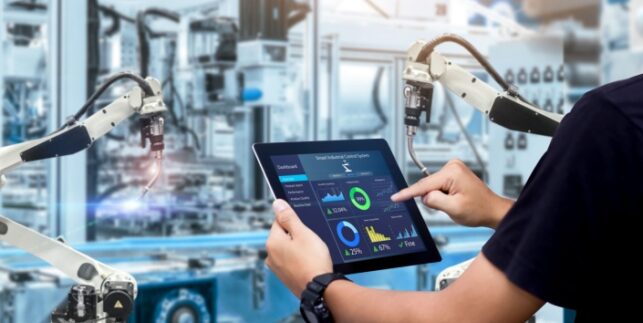The Evolution of Manufacturing Execution Systems (MES): Bridging the Gap with Real-Time Operational Intelligence (RtOI)

Manufacturing Execution Systems (MES) have undergone a monumental transformation over the years, mirroring the paradigm shift the industry is currently experiencing. Initially introduced as tools for recording and monitoring production processes, these systems have rapidly evolved in the face of the digitalization wave sweeping across shop floors globally.
In the context of Industry 4.0, where the emphasis is on interconnected devices, automation, and real-time analytics, MES has morphed into a dynamic system, deeply integrated into various facets of manufacturing, with a notable impact on energy management.
The introduction of Real-time Operational Intelligence (RtOI) has further propelled this transformation, offering an unprecedented window into live operations and empowering decision-makers like never before. As we stand on the threshold of Industry 5.0, which champions deeper human-machine collaborations, the catalyst driving this continuous evolution of MES is undeniably the power and potential of real-time data.
The Imperative for Modernization in MES Systems
Current manufacturing landscapes are experiencing a wave of digitalization that emphasizes transparency, connectivity, and real-time data access. While traditional systems, including advanced control systems and energy monitors, have served their purpose, they no longer suffice in this new era.
Existing systems, in their limited scope, often miss out on providing a holistic understanding of the production floor. Consider energy consumption as an example; Decisions on energy use, influenced by fluctuating factors like peak and off-peak pricing hours, can drastically affect financial outcomes. Relying on outdated systems without real-time insights can not only lead to poor decision-making but also threaten production schedules and commitments.
Manufacturers now need a more integrated approach, one that is anchored in real-time data and enables manufacturers to take a proactive approach to shop-floor management rather than post-mortum reactive approach which is often ineffective and does not enable mitigation of losses. Such an approach not only ensures savings, but also fosters a culture of transparency and adaptability.
As Industry 4.0 and the upcoming Industry 5.0 emphasize interconnectivity and instant data access, the evolution of MES systems isn’t just recommended—it’s imperative, and Real-time Operational Intelligence enables that.
A User-Centric Approach:
- Traditional MES: Think of these as old-school textbooks—dense, unwieldy, and hard to navigate. Their fragmented systems and isolated data make them user-unfriendly, creating operational inefficiencies.
- RtOI Systems: These are the interactive e-learning platforms of today—intuitive, responsive, and designed for the modern user. With tailor-made, no-code apps, they offer solutions crafted for individual challenges, resonating with a digitally-inclined workforce.
Agility Over Rigidity:
- Traditional MES: They are like old steam engines—powerful but slow and resistant to change. The focus is more on maintaining the status quo rather than adapting.
- RtOI Systems: Picture these as hyperloop trains—fast, efficient, and built for adaptability. They accommodate evolving needs, allowing businesses to stay nimble and proactive.
Seamless Data Flow:
- Traditional MES: Often, these are like disconnected reservoirs of information—each holding data but not communicating with one another. This disconnect restricts a comprehensive view of operations.
- RtOI Systems: Imagine them as interconnected lakes—data flows seamlessly, sourced from diverse points. This ensures real-time insights, promoting prompt and informed decisions.
Empowering The Frontline:
- Traditional MES: Often require a middleman for every modification, causing delays. It’s like having to consult an architect for every minor home renovation.
- RtOI Systems: Give the tools directly to those on the ground. It’s akin to providing homeowners with modular solutions to redesign as they see fit, ensuring timely adaptability.
Financially Smart Choices:
- Traditional MES: These can be likened to old mansions—grand but with high maintenance costs, and not always efficient.
- RtOI Systems: They represent modern smart homes—optimized for energy, space, and user comfort, ensuring maximum returns on investments.
Transition to Industry 4.0 and Beyond
As we edge closer to the dawn of Industry 5.0, the craving for real-time insights becomes insatiable. Pioneering this evolution is the Matics’ RtOI solution, which not only heralds a new era in MES but also epitomizes the essence of modern manufacturing. Unlike its predecessors, which dwelled on retrospective analysis, Matics illuminates the present, offering real-time oversight and control.
Central to the ethos of Industry 5.0 is the synergy between man and machine, and it’s here that real-time data emerges as the linchpin. The progression of MES mirrors the manufacturing industry’s trajectory—from simplistic processes to intricate systems demanding agility. In this evolving landscape, platforms like Matics don’t just offer an advantage—they define the new standard, ensuring that every manufacturing decision is informed, timely, and geared for maximum efficiency.





